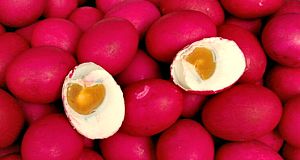Eggs with fissures are sold as sariwa or fresh duck eggs. Eggs with thin shells but have no cracks are made into salted red eggs. Dip eggs in a mixture of salt, garden soil, and water.
As a starter, put 3 can-fulls of salt (using common powdered milk can) to ½ pail of garden soil that have been strained. Add water gradually. Stop adding water to soil when mixture sticks to your fingers when you dip these in the salty muck. Coat eggs with soil-salt mixture and store for 18 days. On the 19th day, wash and hard-boil the eggs.
Finally, dip salted eggs in a solution or red dye. The next batch of eggs can be processed using the previous mixture, but add one can-full of salt. Eggs are stored in a box measuring 14 x 14 x 21 inches.
Pateros Method
A popular method for processing salted eggs in the Philippines is the Pateros method. The salted egg is prepared “Pateros style” by mixing clay (from ant hills or termite mounds), table salt and water in the ratio of 1:1:2 until the admixture becomes smooth and forms a thick texture similar to cake batter. The fresh eggs are individually dipped in the admixture, and packed in 150-egg batches in newspaper-lined 10x12x18 inch wooden boxes (often residual boxes of dried fish packing). The whole batch is then lightly wrapped in newspapers to slow down the dehydration process.
The eggs are then stored indoors at room temperature over the next 12 to 14 days to cure, the salt equilibrating in the batch by osmosis. Curing can last up to 18 days, but that results in very long-lasting red eggs that can have a 40-day shelf life, which is largely unnecessary, as the eggs are stocked and replenished biweekly.
After the two-week curing period, the eggs are hand-cleaned with water and a brush and prepared to be boiled in low heat for 30 minutes Time is measured from the first moment the water boils and the eggs are immersed. A 50-egg batch is then wrapped in fish nets for ease of removal from the cookware, which must be large enough to accommodate the batch with a two-inch covering of water.
Chicken eggs may be processed the same way, although up to 10% of the batch can break during the process.
Source: en.wikipedia.org
